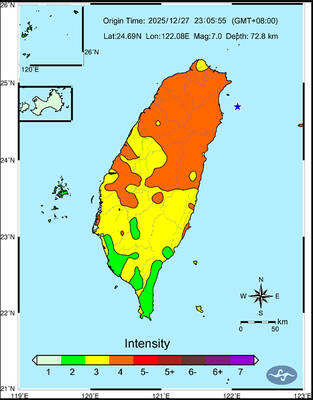The suffocating smog that blanketed swathes of China is now hitting parts of Japan, sparking warnings yesterday of health risks for the young and the sick.
The Japanese Ministry of the Environment’s Web site has been overloaded as worried users log on to try to find out what is coming their way.
“Access to our air pollution monitoring system has been almost impossible since last week and the telephone here has been constantly ringing because worried people keep asking us about the impact on health,” a ministry official said.
Pictures of Beijing and other Chinese cities shrouded in thick, choking smog played out across television screens in Japan last week.
News programs have broadcast maps showing a swirl of pollution gathering strength across China and then spreading out over the ocean toward Japan.
Pinks, reds and oranges that denote the highest concentrations form a finger of smog that inches upward to the main southern island of Kyushu.
Relations between Tokyo and Beijing are already strained, over the sovereignty of the Diaoyutai Islands (釣魚台), claimed by Taiwan, China and Japan, which calls them the Senkakus. On the streets of Tokyo, reaction was tart.
“China is our neighbor and all sorts of problems happen between us all the time,” Takaharu Abiko, 50, said. “It is very worrying. This is dangerous pollution, like poison, and we can’t protect ourselves. It’s scary.”
Japanese officials were coy about lumping all the blame on their huge neighbor, but Yasushi Nakajima of the environment ministry said: “We can’t deny there is an impact from pollution in China.”
Air pollution over the west of Japan has exceeded government limits over the past few days, with tiny particulate matter a problem, Atsushi Shimizu of Japan’s National Institute for Environmental Studies (NIES) said.
Prevailing winds from the west bring airborne particles from the Asian mainland, he said.
Of specific concern is the concentration of particles 2.5 micrometers or less in diameter, which has been as high as 50 micrograms per cubic meter of air over recent days in northern Kyushu. The government’s safety limit is 35 micrograms.
Yellow sand from the deserts of Mongolia and China is a known source of these particles, as are exhausts from cars and smoke from factories.
“At this time of year they are definitely not yellow sand, so they’re toxic particles,” Shimizu said, adding that “people with respiratory diseases should be careful.”
Toshihiko Takemura, an associate professor of Kyushu University who runs another air pollution monitoring site, said “the impact of air pollution originating from China on Japan was scientifically discovered more than a decade ago.”
“Especially in Kyushu, the level of air pollution has been detectable in everyday lives since a few years ago,” he told reporters. “People in eastern and northern Japan are now belatedly noticing the cross-border air pollution.”
Takemura added that pollution in Japan over the past few days has not been quite as bad as it was in February 2011, when “very hazy days continued for several days in western Japan.”

A magnitude 7.0 earthquake struck off Yilan at 11:05pm yesterday, the Central Weather Administration (CWA) said. The epicenter was located at sea, about 32.3km east of Yilan County Hall, at a depth of 72.8km, CWA data showed There were no immediate reports of damage. The intensity of the quake, which gauges the actual effect of a seismic event, measured 4 in Yilan County area on Taiwan’s seven-tier intensity scale, the data showed. It measured 4 in other parts of eastern, northern and central Taiwan as well as Tainan, and 3 in Kaohsiung and Pingtung County, and 2 in Lienchiang and Penghu counties and 1

FOREIGN INTERFERENCE: Beijing would likely intensify public opinion warfare in next year’s local elections to prevent Lai from getting re-elected, the ‘Yomiuri Shimbun’ said Internal documents from a Chinese artificial intelligence (AI) company indicated that China has been using the technology to intervene in foreign elections, including propaganda targeting Taiwan’s local elections next year and presidential elections in 2028, a Japanese newspaper reported yesterday. The Institute of National Security of Vanderbilt University obtained nearly 400 pages of documents from GoLaxy, a company with ties to the Chinese government, and found evidence that it had apparently deployed sophisticated, AI-driven propaganda campaigns in Hong Kong and Taiwan to shape public opinion, the Yomiuri Shimbun reported. GoLaxy provides insights, situation analysis and public opinion-shaping technology by conducting network surveillance

‘POLITICAL GAME’: DPP lawmakers said the motion would not meet the legislative threshold needed, and accused the KMT and the TPP of trivializing the Constitution The Legislative Yuan yesterday approved a motion to initiate impeachment proceedings against President William Lai (賴清德), saying he had undermined Taiwan’s constitutional order and democracy. The motion was approved 61-50 by lawmakers from the main opposition Chinese Nationalist Party (KMT) and the smaller Taiwan People’s Party (TPP), who together hold a legislative majority. Under the motion, a roll call vote for impeachment would be held on May 19 next year, after various hearings are held and Lai is given the chance to defend himself. The move came after Lai on Monday last week did not promulgate an amendment passed by the legislature that

AFTERMATH: The Taipei City Government said it received 39 minor incident reports including gas leaks, water leaks and outages, and a damaged traffic signal A magnitude 7.0 earthquake struck off Taiwan’s northeastern coast late on Saturday, producing only two major aftershocks as of yesterday noon, the Central Weather Administration (CWA) said. The limited aftershocks contrast with last year’s major earthquake in Hualien County, as Saturday’s earthquake occurred at a greater depth in a subduction zone. Saturday’s earthquake struck at 11:05pm, with its hypocenter about 32.3km east of Yilan County Hall, at a depth of 72.8km. Shaking was felt in 17 administrative regions north of Tainan and in eastern Taiwan, reaching intensity level 4 on Taiwan’s seven-tier seismic scale, the CWA said. In Hualien, the